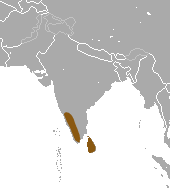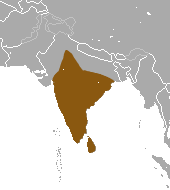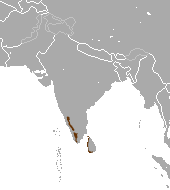Urva (genus)
| Urva | |
|---|---|

| |
| Indian grey mongoose | |
| Scientific classification | |
| Kingdom: | Animalia |
| Phylum: | Chordata |
| Class: | Mammalia |
| Order: | Carnivora |
| Suborder: | Feliformia |
| Family: | Herpestidae |
| Subfamily: | Herpestinae |
| Genus: | Urva Hodgson, 1837 |
| Type species | |
| Gulo urva | |
| Species | |
|
See table and range map | |

| |
Native distribution of Urva species
| |
Urva is a genus comprising the Asian mongooses within the mongoose family Herpestidae. Species in the genus were formerly classified in the genus Herpestes, which is now thought to comprise exclusively African mongooses; phylogenetic evidence indicates that the Asian mongooses form a monophyletic group and had an Asian common ancestor. Urva forms a clade with Xenogale and Atilax, while Herpestes forms a clade with all other African mongoose species.[1][2]
An Urva fossil specimen, an upper molar tooth, was excavated in the Ayeyarwady River valley in central Myanmar and is estimated to date to the late Pliocene.[3]
The scientific name Urva was coined by Brian Houghton Hodgson as the specific name of crab-eating mongoose in 1836,[4] and as the generic name in the following year.[5] Urva species have a wide distribution spanning from the Arabian Peninsula to the Indonesian island of Java.[6] The small Indian mongoose (U. auropunctata) has been introduced to several islands in the late 19th century, where it has become an invasive species.[7][8]
Species[]
Urva comprises the following species:[1]
| Image | Name | Distribution and IUCN Red List status |
|---|---|---|

|
Indian grey mongoose (U. edwardsii) (Geoffroy Saint-Hilaire, 1818)[9] | LC[10]
|

|
Javan mongoose (U. javanica) (Geoffroy Saint-Hilaire, 1818)[9] | LC[11]
|
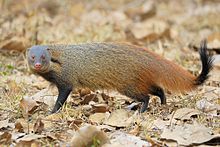
|
Stripe-necked mongoose (U. vitticolla) (Bennett, 1835)[12] | LC[13]
|

|
Small Indian mongoose (U. auropunctata) Hodgson, 1836[4] | LC[14]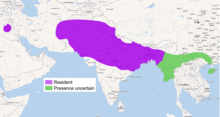
|

|
Crab-eating mongoose (U. urva) Hodgson, 1836[4] | LC[15]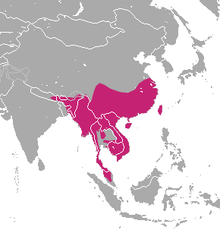
|
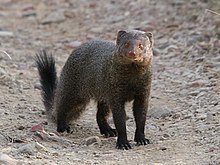
|
Ruddy mongoose (U. smithii) (Gray, 1837)[16] | LC[17]
|

|
Short-tailed mongoose (U. brachyura) (Gray, 1837)[16] | NT[18]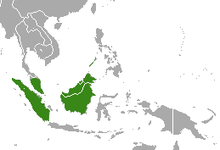
|

|
Indian brown mongoose (U. fusca) (Waterhouse, 1838)[19] | LC[20]
|

|
Collared mongoose (U. semitorquata) (Gray, 1846)[21] | NT[22]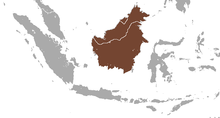
|
References[]
- ^ a b Patou, M.; Mclenachan, P.A.; Morley, C.G.; Couloux, A.; Jennings, A.P.; Veron, G. (2009). "Molecular phylogeny of the Herpestidae (Mammalia, Carnivora) with a special emphasis on the Asian Herpestes". Molecular Phylogenetics and Evolution. 53 (1): 69–80. doi:10.1016/j.ympev.2009.05.038. PMID 19520178.
- ^ Zhou, Y.; Wang, S.-R.; Ma, J.-Z. (2017). "Comprehensive species set revealing the phylogeny and biogeography of Feliformia (Mammalia, Carnivora) based on mitochondrial DNA". PLoS ONE. 12 (3): e0174902. doi:10.1371/journal.pone.0174902. PMC 5373635. PMID 28358848.
- ^ Egi, N.; Nishioka, Y.; Tsubamoto, T.; Ogino, S. & Takai, M. (2011). "A mongoose remain (Mammalia: Carnivora) from the Upper Irrawaddy sediments, Myanmar and its significance in evolutionary history of Asian herpestids". Journal of Asian Earth Sciences. 42 (6): 1204–1209. doi:10.1016/j.jseaes.2011.07.003.
- ^ a b c Hodgson, B. H. (1836). "Synoptical description of sundry new animals, enumerated in the Catalogue of Nepalese Mammals". Journal of the Asiatic Society of Bengal. 5 (52): 231–238.
- ^ Hodgson, B. H. (1837). "On a new genus of the Plantigrades". Journal of the Asiatic Society of Bengal. 6 (67): 560–565.
- ^ Veron, G. & Jennings, A.P. (2017). "Javan mongoose or small Indian mongoose – who is where?". Mammalian Biology. 87 (1): 62–70. doi:10.1016/j.mambio.2017.05.006.
- ^ Lowe, S.; Browne, M.; Boudjelas, S. & De Poorter, M. (2000). "Small Indian Mongoose (Herpestes javanicus (auropunctatus))" (PDF). 100 of the World’s Worst Invasive Alien Species. A selection from the Global Invasive Species Database. New Zealand: The Invasive Species Specialist Group, SSC IUCN, Hollands Printing Ltd. p. 10.
- ^ Louppe, V.; Lalis, A.; Abdelkrim, J.; Baron, J.; Bed’Hom, B.; Becker, A. A. M. J.; Catzeflis, F.; Lorvelec, O.; Zieger, U.; Veron, G. (2021). "Dispersal history of a globally introduced carnivore, the small Indian mongoose Urva auropunctata, with an emphasis on the Caribbean region". Biological Invasions. 23: 2573–2590. doi:10.1007/s10530-021-02523-6.
- ^ a b Geoffroy Saint-Hilaire, É. (1817). "De l'Ichneumon. Ichneumon pharaon". In Jomard, E. F. (ed.). Description de l'Égypte, ou, Recueil des observations et des recherches qui ont été faites en Égypte pendant l'éxpédition de l'armée française. Vol. Tome II. Paris: Commission des Sciences et Arts d'Egypte. pp. 137–144.
- ^ Mudappa, D. & Choudhury, A. (2016). "Herpestes edwardsii". IUCN Red List of Threatened Species. 2016: e.T41611A45206787.
- ^ Chutipong, W.; Duckworth, J. W.; Timmins, R.; Willcox, D. H. A. & Ario, A. (2016). "Herpestes javanicus". IUCN Red List of Threatened Species. 2016: e.T70203940A45207619.
- ^ Bennett, E. T. (1835). "Remarks on some Mammalia from Travancore, including a New Species of Herpestes". Proceedings of the Zoological Society of London. III: 66–67.
- ^ Muddapa, D.; Choudhury, A. & Punjabi, G. A. (2016). "Herpestes vitticollis". IUCN Red List of Threatened Species. 2016: e.T41619A45208503.
- ^ Jennings, A. & Veron, G. (2016). "Herpestes auropunctatus". IUCN Red List of Threatened Species. 2016: e.T70204120A70204139.
- ^ Choudhury, A.; Timmins, R.; Chutipong, W.; Duckworth, J. W.; Mudappa, D. & Willcox, D. H. A. (2015). "Herpestes urva". IUCN Red List of Threatened Species. 2015: e.T41618A86159618.
- ^ a b Gray, J. E. (1837). "Description of some or little known Mammalia, principally in the British Museum Collection". The Magazine of Natural History and Journal of Zoology, Botany, Mineralogy, Geology and Meteorology. I (November): 577–587.
- ^ Mudappa, D. & Choudhury, A. (2016). "Herpestes smithii". IUCN Red List of Threatened Species. 2016: e.T41617A45208195.
- ^ Duckworth, J. W.; Mathai, J.; Ross, J. & Wilting, A. (2016). "Herpestes brachyurus". IUCN Red List of Threatened Species. 2016: e.T41610A45206655.
- ^ Waterhouse, G.R. (1838). "On two new species of Mammalia, from the Society's collection, belonging to the genera Gerbillus and Herpestes". Proceedings of the Zoological Society of London. VI: 55–56.
- ^ Mudappa, D.; Jathanna, D. (2015). "Herpestes fuscus". IUCN Red List of Threatened Species. 2015: e.T41612A45207051.
- ^ Gray, J.E. (1846). "New species of Mammalia". The Annals and Magazine of Natural History; Zoology, Botany, and Geology. 18 (118): 211–212.
- ^ Mathai, J.; Hearn, A.; Brodie, J.; Wilting, A.; Duckworth, J. W.; Ross, J.; Holden, J.; Gemita, E. & Hon, J. (2015). "Herpestes semitorquatus". IUCN Red List of Threatened Species. 2015: e.T41616A45208027.
External links[]
- "ASM Mammal Diversity Database". www.mammaldiversity.org. Retrieved 2021-07-08.
- Urva (genus)
- Mammal genera
